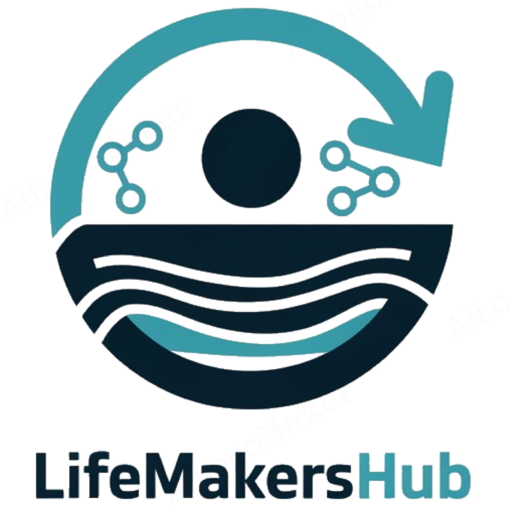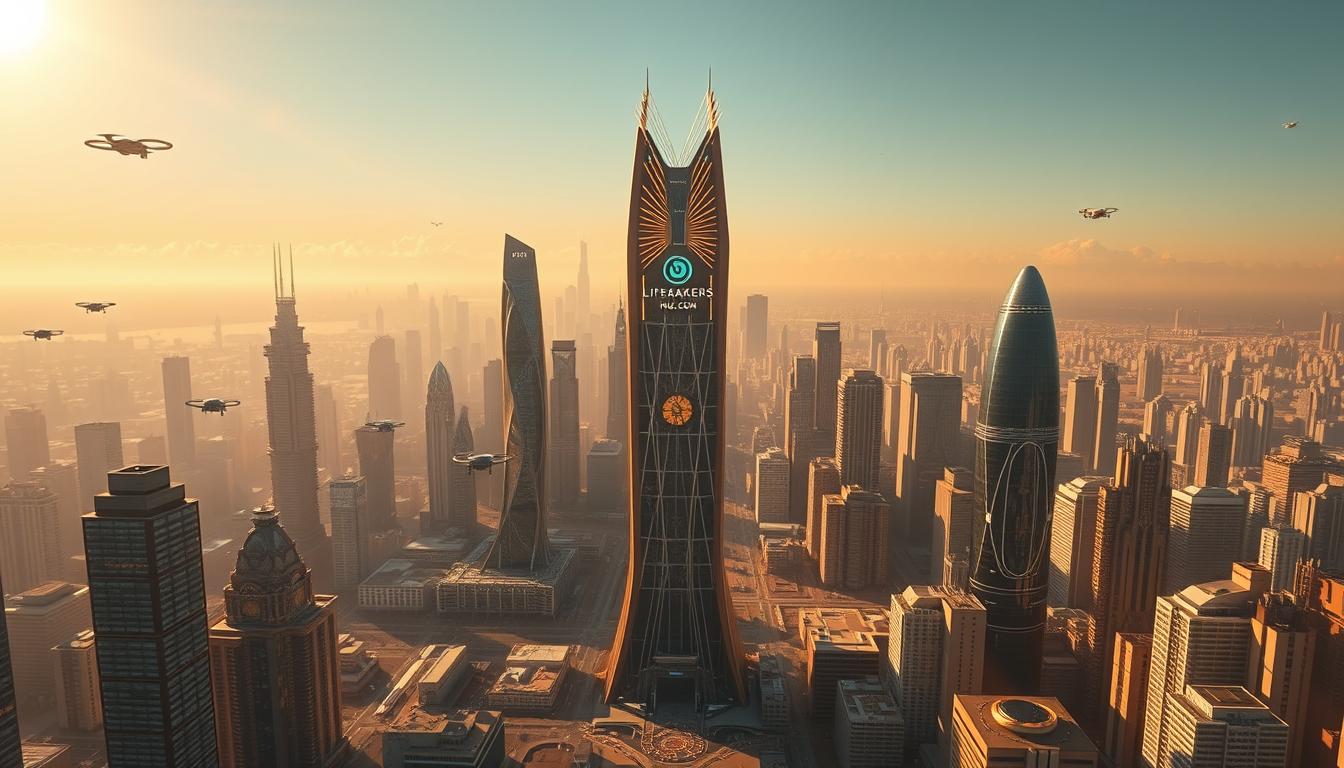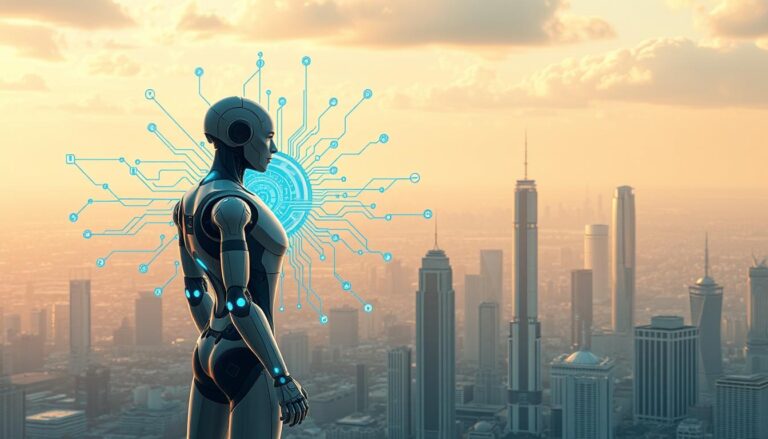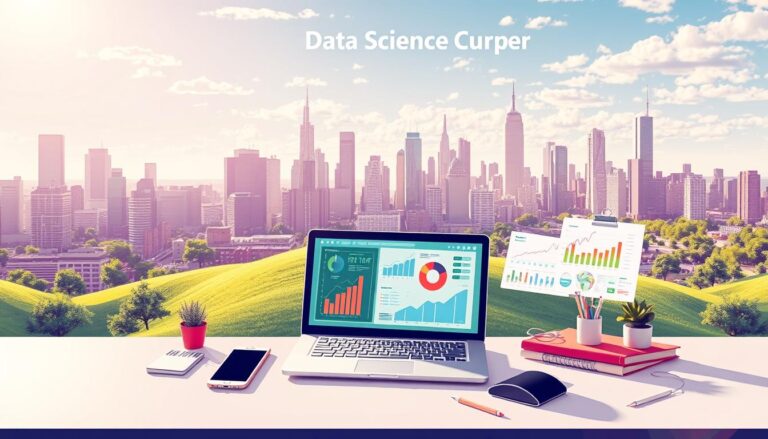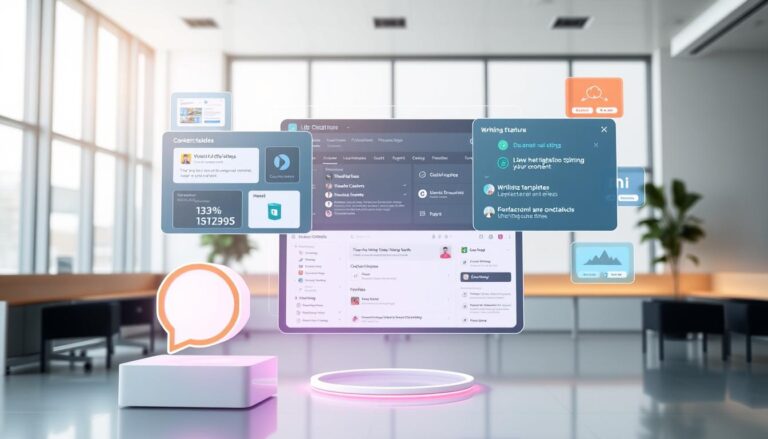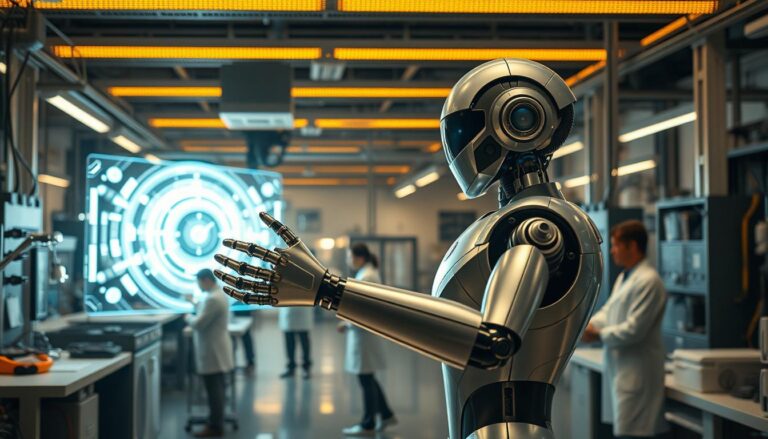The Future Tech to Keep an Eye on by 2030
The world is evolving rapidly, driven by groundbreaking technology that reshapes industries and daily life. From artificial intelligence to virtual reality, these advancements are not just trends—they’re transformative forces. Understanding these changes helps us prepare for what’s next.
Over the years, innovation has laid the foundation for today’s cloud-based solutions and AI-driven systems. These tools are enhancing productivity and creating new opportunities across business sectors. For example, AI is automating tasks like fraud detection and predictive maintenance, while IoT is improving energy management and operational efficiency1.
This article explores how these technologies are shaping the future. We’ll dive into their applications, benefits, and the ways they’re changing the game. Whether you’re a professional or simply curious, this guide offers valuable insights into the next wave of technology.
Key Takeaways
- AI and IoT are driving efficiency and innovation in various industries.
- Cloud computing is becoming a primary solution for businesses.
- Virtual reality is transforming training and collaboration.
- Understanding past trends helps predict future advancements.
- These technologies are reshaping productivity and daily life.
Introduction: Setting the Stage for Tomorrow’s Technologies
From humble beginnings, tech has become a cornerstone of modern life. The shift from simple tools to advanced systems has transformed how we work, communicate, and live. Understanding this journey helps us prepare for what’s next.
Understanding the Shift from Past to Future
In the 1980s, personal computers revolutionized workplaces. By the 2000s, mobile phones and telecommuting became the norm. These changes laid the groundwork for today’s innovation in cloud computing and AI-driven systems2.
For example, the global IT market reached $9.48 trillion in 2022 and is projected to grow at an 11.0% CAGR by 20283. This growth highlights the rapid adoption of technology across industries.
Key Trends Shaping the Next Decade
Several trends are set to redefine the world of tech. Hybrid work, AI integration, and immersive experiences like virtual reality are leading the way. By 2028, over 80% of Fixed Wireless Access connections will be 5G-based2.
Here’s a quick look at some key areas:
| Trend | Impact |
|---|---|
| AI Integration | Automating tasks and enhancing decision-making |
| 5G Expansion | Enabling faster, more reliable connectivity |
| Immersive Tech | Transforming training and collaboration |
These advancements are not just trends—they’re shaping the future of how we live and work.
Tracing the Evolution of Workplace Technology
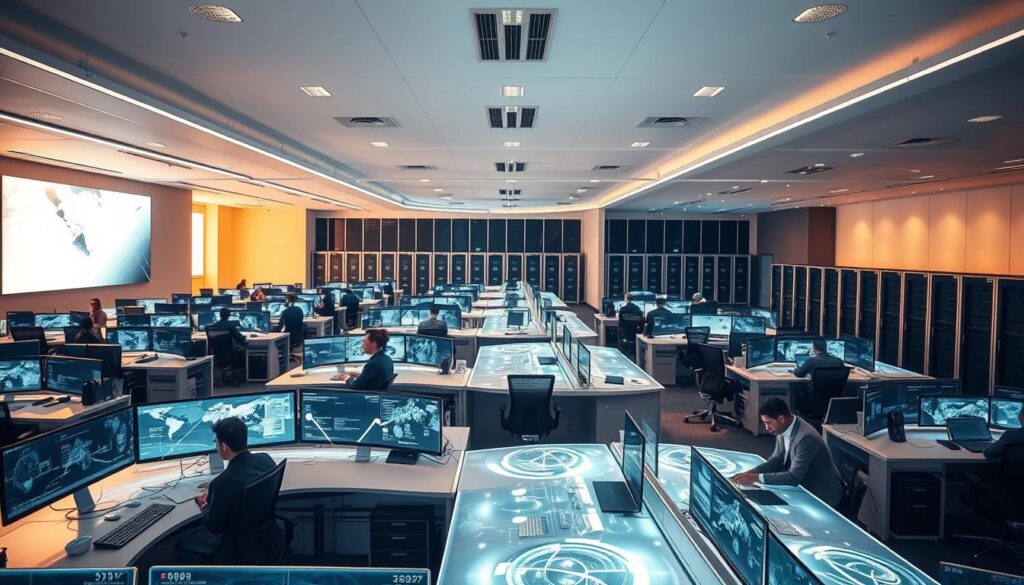
The journey of workplace technology has been a transformative one, reshaping how we work and connect. From the early days of personal computers to the rise of telecommuting, each era has brought new tools and methods that redefine productivity and collaboration.
From Personal Computers to Telecommuting
In the 1980s, personal computers revolutionized workplaces, boosting efficiency and enabling new ways to handle tasks. Companies like IBM and AT&T were pioneers, introducing systems that streamlined operations and improved communication. By the 1990s, the internet and email systems accelerated remote work, laying the foundation for today’s telecommuting solutions4.
For example, early remote collaboration tools, though less creative than in-person work, paved the way for modern platforms. Recent advancements have improved outcomes, making remote collaboration more effective than ever4.
Impact of Historical Trends on Modern Tech
Historical trends continue to shape modern technology. The introduction of PCs boosted productivity, while the internet created a global network for information sharing. Today, these innovations form the backbone of cloud-based systems and AI-driven platforms5.
Companies like American Express embraced these changes early, adopting tools that enhanced efficiency and employee satisfaction. These lessons from the past guide the development of new technologies, ensuring they meet the needs of today’s workforce.
For instance, 24% of clerical tasks are now highly exposed to automation, with 58% at medium-level exposure4. This shift highlights the ongoing impact of historical advancements on workplace dynamics.
Innovation in Hybrid and Remote Work Environments
Hybrid work environments are reshaping how businesses operate, blending flexibility with productivity. This shift has driven the need for advanced technology that supports seamless collaboration and efficient workflows. Companies are investing in tools that bridge the gap between remote and on-site teams, ensuring everyone stays connected and productive6.
Technologies Enabling Seamless Collaboration
The evolution of communication tools has been remarkable. From basic cloud-based systems to integrated audio/video setups, these advancements are transforming how teams interact. For example, virtual whiteboards and apps like Google Workspace allow real-time collaboration, while high-quality conferencing equipment ensures clear and professional meetings7.
Survey insights show that 80% of companies are increasing their investment in collaboration tools. This trend highlights the growing importance of innovation in maintaining productivity and connectivity in hybrid work models6.
Data-Driven Workplace Platforms
Data-driven platforms are playing a critical role in optimizing hybrid work environments. These tools help businesses manage space, reduce costs, and improve efficiency. For instance, platforms that track office usage can inform decisions about desk allocations and meeting room availability8.
By leveraging data, companies can create smarter workplaces that adapt to employee needs. This approach not only enhances productivity but also fosters a more connected and engaged workforce7.
Future technologies to watch by 2030
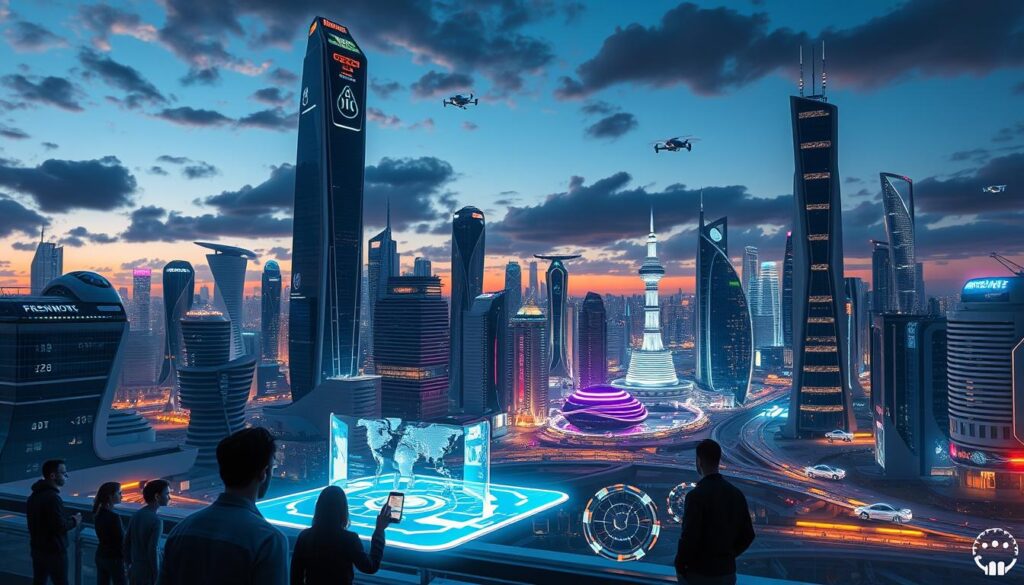
The next decade will bring transformative shifts in how businesses operate and innovate. Emerging trends like AI, cloud computing, and IoT are already reshaping industries, offering new opportunities for growth and efficiency. These advancements are not just buzzwords—they’re game-changers that will define the market landscape.
Emerging Trends in Business and Productivity
AI-driven processes are revolutionizing how companies operate. By 2030, AI is expected to power automation and advanced analytics across various industries, enhancing efficiency and personalized solutions9. For example, AI is already automating tasks like fraud detection and predictive maintenance, saving businesses time and resources.
Cloud computing is another key driver of productivity. The cloud market is still in its early stages, with significant growth expected as more businesses adopt it beyond pandemic-related measures10. This technology enables scalable, cost-effective solutions that support remote and hybrid work environments.
IoT is also transforming industries by connecting devices and gathering valuable data. Smart devices are becoming the norm, contributing to the expansion of the IoT network, which continuously gathers data10. This connectivity enhances operational efficiency and customer engagement, giving businesses a competitive edge.
Here’s a quick look at how these trends are shaping the future:
- AI Integration: Automating tasks and enhancing decision-making.
- Cloud Innovations: Providing scalable, cost-effective solutions.
- IoT Expansion: Improving connectivity and data-driven insights.
Self-driving cars and nanotechnology are also set to make a significant impact. By 2030, the autonomous car market is projected to grow to 13.7 billion U.S. dollars, with one in ten vehicles globally expected to be self-driving10. Nanotechnology, meanwhile, is increasingly utilized in industrial and medicinal applications, with growing importance in the energy sector, particularly for hydrogen fuel cells10.
Staying ahead of these trends is crucial for businesses aiming to thrive in a rapidly changing digital landscape. Adopting these breakthrough technologies will not only enhance operational efficiency but also drive innovation and customer satisfaction.
Artificial Intelligence and the Innovation Wave

Artificial intelligence is reshaping industries, driving efficiency, and unlocking new possibilities. From smart assistants to complex industrial systems, AI is becoming ubiquitous. Its integration across sectors is accelerating, setting new standards for productivity and innovation.
Advancements in Machine Learning
Machine learning is at the heart of AI’s evolution. It enables systems to learn from data, improving accuracy and reducing errors over time. For example, AI-powered fraud detection systems are now faster and more reliable than human-driven methods11.
These advancements are transforming industries. In healthcare, AI is reducing human errors that cost thousands of lives annually11. In finance, it’s predicting market trends with unprecedented precision11.
Integration of AI Across Industries
AI’s integration is not limited to one sector. In manufacturing, robots powered by AI are enhancing production efficiency. In transportation, autonomous vehicles are reducing accident rates by 40%11.
The market for AI is growing rapidly. By 2030, it’s expected to power automation and advanced analytics across multiple industries12. Companies like Tesla and Google are already leading the way, showcasing the potential of this technology.
Here’s how AI is making an impact:
- Healthcare: Reducing errors and accelerating drug discovery11.
- Finance: Predicting trends and improving fraud detection11.
- Manufacturing: Enhancing efficiency with AI-driven robots.
AI is not just a trend—it’s a foundational change in how businesses operate. Embracing this innovation is key to staying competitive in today’s fast-paced market.
Cloud Computing: Opportunities and Security Challenges

Cloud computing has become a cornerstone of modern business operations, offering unparalleled scalability and efficiency. As organizations increasingly rely on this technology, understanding its evolution and challenges is essential. From public to hybrid models, the cloud is reshaping how businesses operate and innovate13.
Growth of Public, Private, and Hybrid Clouds
The adoption of cloud computing has surged, with the market projected to reach $864 billion by 202513. Public clouds offer cost-effective solutions, while private clouds provide enhanced security for sensitive data. Hybrid models combine the best of both, enabling flexibility and scalability for businesses of all sizes14.
For example, hybrid cloud environments are becoming the norm, allowing companies to leverage multiple providers for optimized performance. This approach not only reduces cost but also enhances operational efficiency13.
Securing the Digital Workspace
As cloud adoption grows, so do security challenges. Cybersecurity threats, such as data breaches and ransomware attacks, are on the rise. To combat these risks, organizations are implementing advanced measures like zero-trust architecture and multi-factor authentication14.
Cloud Access Security Brokers (CASBs) are also gaining traction, providing real-time monitoring and threat detection. These tools help safeguard sensitive information, ensuring compliance with regulations like GDPR and CCPA13.
Here’s how businesses can enhance cloud security:
- Adopt zero-trust models: Verify every access request, regardless of origin.
- Use multi-factor authentication: Add an extra layer of protection for user accounts.
- Leverage CASBs: Monitor and secure cloud-based activities in real-time.
By addressing these challenges, organizations can fully harness the potential of cloud computing while maintaining a secure digital workspace14.
The Internet of Things and Next-Gen Connectivity
The Internet of Things (IoT) is revolutionizing how devices communicate, creating a seamless network of interconnected systems. From smart homes to industrial applications, IoT is driving a new wave of innovation that enhances productivity and efficiency15.
By the end of 2023, there were 16.6 billion connected IoT devices, marking a 15% growth over the previous year15. This rapid expansion is expected to continue, with projections of 18.8 billion devices by the end of 202415. The global IoT market is also set to reach $1.1 trillion by 2026, reflecting its growing importance across industries16.
Expanding Smart Device Ecosystems
IoT is transforming both consumer and industrial spaces. In homes, smart thermostats, security cameras, and voice assistants are becoming commonplace. In offices, IoT-enabled devices streamline operations, from energy management to inventory tracking17.
Wi-Fi accounts for 31% of all IoT connections globally, while Bluetooth and cellular technologies like 5G are also playing significant roles15. These advancements enable real-time data exchange, improving decision-making and operational efficiency16.
Here’s a breakdown of IoT connectivity types:
| Type | Usage |
|---|---|
| Wi-Fi | 31% of global IoT connections |
| Bluetooth | 25% of global IoT connections |
| Cellular (5G, 4G, etc.) | 21% of global IoT connections |
IoT ecosystems foster a more integrated and automated environment. For example, in manufacturing, IoT sensors monitor equipment performance, reducing downtime and costs17. In healthcare, wearable devices track patient vitals, enabling proactive care16.
As IoT continues to grow, its impact on business and daily life will only deepen. Companies investing in this technology are positioning themselves for long-term success in an increasingly connected world15.
Self-Driving Cars and the Transformation of Transportation
Self-driving cars are no longer a distant dream but a reality reshaping transportation. Powered by technology like AI and advanced sensors, these vehicles are redefining mobility. They promise safer roads, reduced congestion, and a new era of urban planning.
Autonomous Vehicles and Safety Innovations
Autonomous vehicles rely on cutting-edge systems like lidar and machine learning to navigate roads. These devices detect obstacles, interpret traffic signals, and make real-time decisions. By 2035, advanced autonomous features could be in 37% of new passenger cars18.
Safety is a top priority. Self-driving cars are designed to reduce human error, which causes 94% of accidents. Innovations like collision avoidance and adaptive cruise control are making roads safer18.
Companies like Tesla and Ford are leading the charge. Tesla’s Autopilot and Ford’s collaboration with Argo AI are testing autonomous delivery services in cities like Miami and Austin19.
Here’s how self-driving cars are transforming transportation:
- Reduced Accidents: Autonomous systems minimize human error, lowering crash rates.
- Efficient Mobility: Self-driving cars optimize routes, reducing traffic congestion.
- Market Growth: The autonomous car market is projected to reach $13.7 billion by 203018.
As this innovation evolves, it will reshape how we travel. From daily commutes to long-distance trips, self-driving cars are set to revolutionize transportation18.
Nanotechnology: Pioneering Material Science and Innovation
Nanotechnology is reshaping industries with its ability to manipulate materials at the atomic level. This technology is unlocking new possibilities in material science, enabling breakthroughs that were once unimaginable. From stronger industrial components to advanced medical treatments, nanotechnology is driving the next wave of innovation.
Breakthroughs in Industrial and Medical Applications
In the industrial sector, nanotechnology is creating stronger, lighter, and more durable materials. For example, nanoparticles are being used to enhance the performance of products like coatings and adhesives. These advancements are reducing costs and improving efficiency across various industries20.
In healthcare, nanotechnology is revolutionizing treatments and diagnostics. Nanoparticles can deliver medication directly to cancer cells, minimizing damage to healthy tissue. This targeted approach is improving treatment effectiveness and reducing side effects20.
The global nanotechnology market is projected to grow from $79.14 billion in 2023 to $248.56 billion by 2030, reflecting its increasing importance21. Companies like Applied Materials and Enphase Energy are leading the way, showcasing the potential of this technology in renewable energy and manufacturing21.
Nanotechnology is also playing a crucial role in energy storage and water purification. Nano-enhanced solar cells can double the amount of sunlight converted into electricity, while nanomaterials are improving water quality by filtering contaminants at a microscopic level20.
As this innovation continues to evolve, it will drive the next wave of product and material advancements. From industrial applications to medical breakthroughs, nanotechnology is paving the way for a more efficient and sustainable future.
Virtual and Augmented Reality: Beyond Entertainment
Virtual and augmented reality are stepping out of the gaming world and into everyday life, transforming how we work and connect. These immersive technologies are no longer just for entertainment—they’re reshaping industries and creating new opportunities for collaboration and creativity.
From virtual meetings to augmented training programs, VR and AR are breaking barriers. Companies are leveraging these tools to enhance productivity and engagement. For example, virtual meeting platforms like Spatial allow teams to collaborate in 3D spaces, making remote work feel more interactive22.
Immersive Experiences in Work and Leisure
In the workplace, VR and AR are revolutionizing training and collaboration. Augmented reality tools overlay digital information onto physical environments, enabling workers to access real-time data and instructions. This is particularly useful in industries like manufacturing and healthcare, where precision is critical23.
Leisure activities are also getting a boost. Virtual reality is creating immersive experiences in travel, fitness, and even social interactions. Platforms like VRChat allow users to meet in virtual worlds, offering a new way to connect with others22.
Here’s how businesses can integrate VR and AR into their operations:
- Virtual Training: Use VR for hands-on training in a safe, controlled environment.
- Augmented Collaboration: Implement AR tools for real-time team collaboration.
- Customer Engagement: Create immersive experiences to enhance customer interaction.
The market for VR and AR is growing rapidly. By 2030, these technologies are projected to contribute £1.4 trillion to the global economy22. This growth highlights their potential to drive innovation across various sectors.
As VR and AR continue to evolve, their applications will expand. Businesses that adopt these technologies early will gain a competitive edge, offering enhanced experiences and improved efficiency. The future of work and leisure is immersive, and the time to embrace it is now.
Tech Innovations in Healthcare and Education
Healthcare and education are undergoing a remarkable transformation, driven by cutting-edge innovations. These advancements are not just improving outcomes but also reshaping how we approach patient care and learning. From personalized medicine to immersive educational tools, technology is at the heart of this evolution.
Personalized Medicine and Digital Health
Personalized medicine is revolutionizing healthcare by tailoring treatments to individual needs. This approach leverages data from genetic testing, lifestyle factors, and medical history to create customized care plans. For example, AI-powered tools can predict patient responses to specific medications, reducing trial-and-error in treatment24.
Digital health tools are also enhancing patient care. Remote monitoring devices track vital signs in real-time, allowing doctors to intervene before conditions worsen. The global women’s health market is projected to reach $512.6 billion by 2028, reflecting the growing demand for these solutions25.
Here’s how digital health is transforming care:
- Remote Monitoring: Devices track health metrics, enabling proactive care.
- AI Diagnostics: Tools analyze medical data for faster, more accurate diagnoses.
- Telehealth: Virtual consultations make healthcare accessible to more people.
EdTech Revolution with VR and AR Tools
Education is embracing immersive technology to create engaging learning experiences. Virtual reality (VR) and augmented reality (AR) are transforming classrooms, offering students hands-on learning opportunities. For instance, VR can simulate historical events or scientific experiments, making abstract concepts tangible24.
AR tools are also enhancing training programs. Medical students can practice surgeries in a virtual environment, reducing risks and improving skills. The market for immersive reality technology is booming, with billions invested annually24.
Here’s a look at how VR and AR are reshaping education:
| Application | Impact |
|---|---|
| Virtual Field Trips | Students explore global landmarks without leaving the classroom. |
| AR Training | Workers practice complex tasks in a safe, controlled environment. |
| Interactive Learning | Students engage with 3D models to understand complex topics. |
These innovations are democratizing access to quality education and healthcare. By leveraging technology, we can create a more inclusive and efficient future for all.
Conclusion
Innovation continues to reshape industries, offering new ways to solve challenges and drive efficiency. From AI automating tasks to cloud computing enabling scalable solutions, these advancements are transforming how we work and live. The integration of IoT and self-driving cars is creating smarter, more connected systems, while nanotechnology and VR/AR are pushing boundaries in material science and immersive experiences26.
Understanding past trends helps guide investments in emerging technology. For instance, AI is projected to contribute $15.7 trillion to the global economy, while IoT connections are expected to reach 18.8 billion by 202427. These breakthroughs are not just trends—they’re reshaping industries and creating competitive advantages.
As we move forward, staying informed about these advancements is crucial. Whether you’re a professional or simply curious, exploring these innovations can unlock new opportunities. Let’s embrace this era of tech and continue to learn, adapt, and thrive.
FAQ
What are the key trends shaping the next decade in technology?
How is AI being integrated across industries today?
What role does cloud computing play in modern workplaces?
How is the Internet of Things (IoT) expanding smart device ecosystems?
What are the latest innovations in autonomous vehicles?
How is nanotechnology impacting material science and healthcare?
What are the applications of virtual and augmented reality beyond entertainment?
How is technology revolutionizing healthcare and education?
Source Links
- The new Essential Eight technologies
- Four Technology Trends to Watch
- The Future of IT: Trends That Will Shape the Tomorrow
- Predicting the unpredictable: How will technology change the future of work?
- Realizing 2030: Future of Work Report
- A Comprehensive Guide to the Future of Work in 2030
- The Future of Work in 2030: Revolution or Evolution?
- What Will the Workplace Look Like in 2030?
- Which Technologies Will Dominate in 2030? | Future Tech Trends
- Will Emerging Technologies Shape The Future?
- The Future of AI: These Four Industries Will Change by 2030
- Which Technologies Will Dominate in 2030? | Future Tech Trends
- The Future of Cloud Computing 2025-2030: Trends and Predictions | CloudDefense.AI
- The Future of Cloud Computing: Predictions and Trends | Blog
- State of IoT 2024: Number of connected IoT devices growing 13% to 18.8 billion globally
- These 25 Technology Trends Will Define The Next Decade
- Internet of Things
- Autonomous driving’s future: Convenient and connected
- The future of transport: driving change in the next 10 years
- Top 10 nanotechnology innovations for 2025
- The Promise and Potential of Nanotechnology Investments — Nano Magazine – Latest Nanotechnology News
- Virtual and augmented reality could deliver a £1.4trillion boost to the global economy by 2030 – PwC
- Which Technologies Will Dominate in 2030? | Future Tech Trends
- Technology in 2030: Top 20 big tech predictions
- Healthcare technology trends 2023–2030: 13 digital health trends to shape the next decade
- Top 10 Future Technologies That Will Transform Modern World by 2030 and Beyond
- 10 Tech Trends That Will Shape the Next Decade | Entrepreneur
